I said nothing close to the world needing to stop.
I’ve seen horses and people do things they never should have survived and I’ve seen the exact opposite.

I said nothing close to the world needing to stop.
I’ve seen horses and people do things they never should have survived and I’ve seen the exact opposite.
This hitting your kneecap on something. A slab fracture is when it is broken all the way across
I think there is a difference between a one off, wow that was a freak accident and a this same type of accident keeps occurring under X,Y, Z conditions. The former- yes it’s a tragedy and yes we should probably look into what happened with that individual horse and rider. The later- we need to be looking at what is happening in the sport and how to fix it.
Can I throw something out there that may be just a ponderable?
Look at where the horse’s nose is pointing in the picture above - to the ground with a short neck. This is the picture of modern over fences. Look at older photos at max effort - neck outstretched and nose out in front. Take note of what it looks like where the neck joins the body … it’s thick and relatively smooth into the chest.
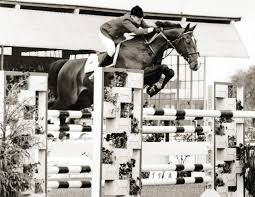
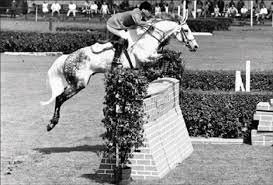
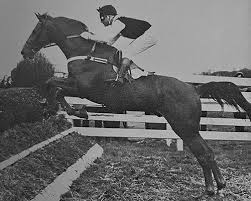
This is older but this is clearly not a safe jumper at height, look at hanging knees but also position of head/neck. The underside of the neck is not stretched and the neck looks like a separate part of the body from the chest/pecs (which makes sense since this horse doesn’t seem to be flexible or strong enough to lift the forearms very high.)
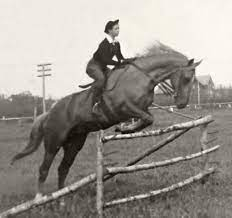
And the denoument … look at this from the Tokyo Olympics. The nose points down and look how short the neck. See the musculature in use, look at the “knees to eyeballs” musculature in the chest. This is amazing breeding, look how the front legs are joined to the body and the flexibility there. Do you see how loose those muscles are, though, under the neck and in the chest? If the neck were longer, could that help maximize the jumping effort?
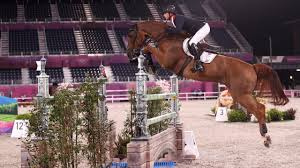
Earlier, it was pointed out how the horse’s structure is reliant on that front end and if it fails catastrophically it’s a death sentence as it’s almost impossible to heal even with modern technology. Following that, the front end structure is also critical to locomotion, the nuchal ligament, that giant skull/neck counterweight diving forward to generate momentum to PULL the body into a different location. Like a baseball pitch using whole body vs. only using upper body.
Earlier, it was said that Michael Jung would have made this course look good. (Agreed!!) Here’s a photo of him leaving the ground … look at how he’s ALLOWING the horse to move his nose out. Look at the underside of the neck. (It’s in use.)
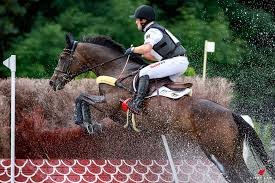
I’m not picking on anyone, just pointing out that maybe the riding style that many modern riders use (more dressage-y frame over fences maybe?) might be contributing to falls?
Again, just a theory. Many, many, many great modern photos with noses outstretched. But also many with noses tucked in. I’d love to see anyone look at riding style prior to falls to analyze further.
Hell, could we save even a couple by going back to teaching automatic release and push the horse head and nose away from the body. Would an inch help, even?
I have been saying the same thing to myself almost every time I see someone jumping. What the heck has happened to the release? Where the hell did it go?
I’m really curious about this and want to look more into it. Is this proportional figure based on the total number of horses that left the start box at a given level or just a flat figure? It would make sense to me that more falls and injuries happen at 2/3* because there are more people and events running at that level.
When horse shopping last year I actually ended up buying a horse with a less than perfect record, despite looking for a horse with ‘no stop that would jump from any distance’. I tried one of those and it scared the crap out of me and learned a horse saying “this isn’t going to work out well, so I’m going to politely decline” is way safer. Self preservation is something I want my horse to have - and some horses have it trained out of them. I’m now one of those who pats her on the neck and re approaches after a stop versus a smack with a crop.
100%. I’m not an Olympian who needs to bring home a medal for my country, nor can my horse count on me to pick distances nearly so well. My priority isn’t a clear round every single time, my priority is to come home safe and able to work at my desk job later the next week so I can pay for my life and that of my horse. I don’t want a horse that isn’t genuine, nor do I want a dirty stopper, but a horse that says “um, that thing you want isn’t doable” and comes around for a second try without holding it against me (even when they have every right to) is the horse I want in my barn. All day every day.
No offense but when you break bones in your leg. You are not euthanized. It’s not fair to compare. Carry on.
100% agree, and I don’t think I would have said that a year ago. I float the reins and let her sort it out if I’m not sure, and if she says no, I’m glad she has enough sense for the both of us! Like you, I’m no Olympian and maxed out at training, my goal is to have a happy horse and have fun, and the margin of error is too small at Prelim for my own comfort.
JESUS. I do not want to ever see this in real time. Is this what eventing is anymore?
I think you hit the nail on the head about why it is so hard to judged risks and rewards in Eventing. Risk management is a nuanced and personal things and that why it can be so hard to make general safety guidelines. It’s easy to say something like get rid of all tables but is that really necessary when most horses are jumping them safely? Is it really necessary to tighten rider qualifications when a lot of people at the upper levels are professionals riding multiple horses ? Do we need to make rider qualifications more involved for amateur? These are just a few examples of why reducing risk can be so difficult. I believe that in order to keep eventing as a viable sport it will take a combination of rethinking course design and rider education. I am not sure what the best way to balance those things.
We teach about 4000 lessons a year and have done so for 50+ years at our place. Number of horse fatalities or catastrophic injuries while being ridden: 0. Number of fatal or catastrophic pasture accidents: 0. “Aaahh, but the horses are not being ridden at an elite level of competition.” Exactly. They are trained to walk, trot and canter on a loose rein, jump small courses, and go on slow trail rides. That’s all I expect of them. I believe it’s pleasant enough for them and I don’t have to lie awake at night asking myself if we expect too much of them or made an unfair request. Will happily stay in my niche and my lane. I tell my young students that if they aspire to upper level eventing, and care about horses, they need to pick a new goal.
I’ve Fence Judged since 2000, at multiple events each year, and therefore have seen literally thousands of horses go past - 280 competitors per day is the maximum for BE. Over this period, I have had two horse fatalities. One chestnut had a heart attack just before the fence. One grey had a slow motion slide into a ditch in which the horse broke it’s neck and had to be euthanised. A memorial section was run the following year. I’ve had two rotational falls at my fences and fortunately neither had dire consequences. Most days pass with stops, run outs and occasionally a rider fall. Anecdotal I know, but I continue to support and enjoy eventing because in my experience it is not as dangerous as some people make it out to be.
Bin there, done that.
We used a grinder to cut him out. Guess all floats are horse abuse now!
Athen 2000 Olympics. I believe a horse died in the dressage warm-up ring. Not sure if it was the able or para dressage.
Heart attack.
So, because you are happy to plod around, your students aren’t allowed bigger aspirations?
That’s bad teaching, right there. Why not encourage your students to think for themselves, about the capabilities of their horse, themselves, consequences for pushing those boundaries, and what is required to achieve the student’s goals without compromising that horse. If the student decides for themself that they cannot risk or push their horse, or that eventing is too risky - good for them.
But you gatekeeping their goals because you don’t like the sport? Wow.
I also don’t encourage flat racing, steeplechasing, Saddleseat, Tennessee Walker shows, AQHA Western Pleasure, and multi week hunter shows with no turn out. We actually have had multiple of students go on to upper level eventing, Pan Am games and USEA teams included–not at my place, and not on my horses! I feel 100% entitled to gatekeep what people will do on my lesson horses. What they do on their own horses down the line is on their own conscience
Jesus, that horse was trying his best to do what was expected of him, even if it meant jumping headfirst through a wall. I hope he was OK. My heart hurts for him.
Thank you for respecting the horse. They trust us and willingly do their best to please and they should be allowed to say NO to anything beyond the scope of their athleticism.
I support having set standards and goals for your lesson horses and students. And I think you fill a very important niche. I am also not sure why you feel the need to bash another discipline when you state those goals. The way you put it above it makes it sound like anyone who events doesn’t care about their horse . Why can’t it just be a simple statement saying I want to mitigate wear and tear on my horses so if you want to do more then w/tc and jump small courses you need to find a different situation? The reality is that EVERYTHING we do with horses is risky and everyone has different levels of risk they are going to take.